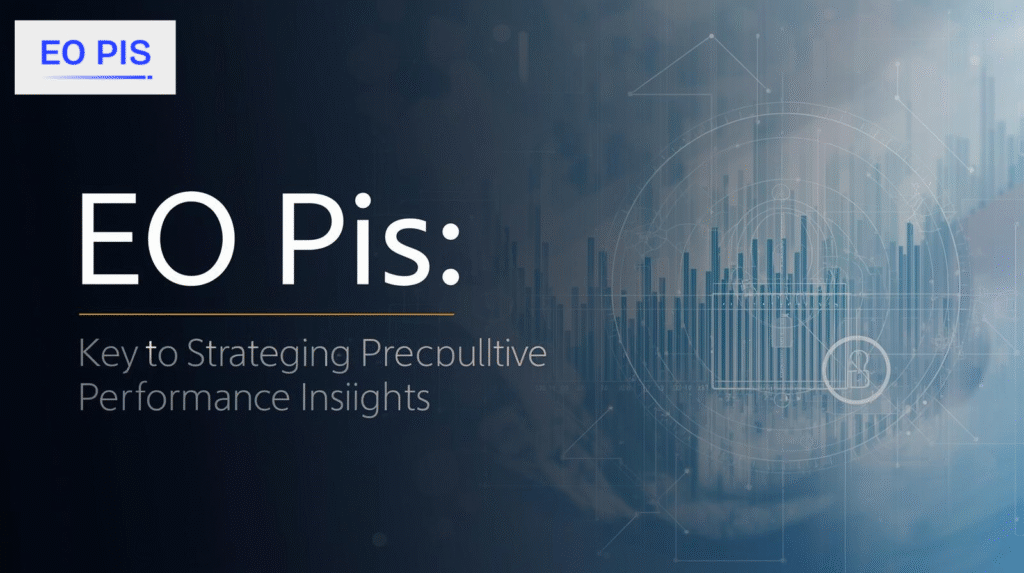In today’s fast-paced business environment, staying ahead of the competition requires more than just tracking performance; it demands a strategic approach that combines real-time dashboards, data-driven decision making, and executive-level insights. This is where EO Pis (Executive Operations Performance Indicator System) comes into play. In this article, we’ll explore the meaning, components, benefits, real-world applications, challenges, and future trends surrounding EO Pis, providing a comprehensive guide to help organizations enhance their leadership decision-making and performance.
What Is EO Pis?
EO Pis is a powerful framework designed to support C-suite executives in tracking, analyzing, and optimizing organizational performance. Unlike traditional performance metrics, EO Pis integrates data across various departments, giving leadership a bird’s-eye view of how different functions align with corporate strategy. This system offers real-time data insights, automating much of the data collection and analysis, which helps leaders make informed decisions quickly and efficiently.
At its core, EO Pis merges performance tracking with strategic alignment, providing a comprehensive tool for leaders to drive growth and operational efficiency.
Defining EO Pis – What Does It Really Mean?
EO Pis, in a business context, stands for Executive Operations Performance Indicator System. It is a tool that allows top-level executives to monitor key metrics across departments, ensuring alignment with company-wide objectives. While traditional KPIs focus on departmental performance, EO Pis consolidates these into one system that enables executives to make high-level decisions based on a full-picture view of operations.
EO Pis is not a replacement for KPIs; rather, it enhances them by integrating them into a centralized executive dashboard that supports cross-departmental coordination and performance optimization.
Key Components of EO Pis Systems
The strength of EO Pis lies in its key components, each working synergistically to provide actionable data insights:
- Centralized Executive Dashboard: This dashboard aggregates key data from across all departments and presents it in an easy-to-understand format. Executives can quickly assess performance and make decisions without sifting through individual departmental reports.
- Strategic KPI Mapping: EO Pis maps traditional KPIs to strategic reporting goals, ensuring that every metric is aligned with long-term business objectives.
- Real-Time Automation: By automating the collection and analysis of data, EO Pis removes the need for manual reporting and outdated spreadsheets, delivering up-to-the-minute insights to executives.
- Predictive Analytics: Advanced EO Pis systems include forecasting tools that help executives anticipate future trends, risks, and opportunities, empowering proactive leadership and performance.
EO Pis vs Traditional KPIs – Key Differences
While EO Pis and KPIs serve similar purposes, they differ significantly in scope and application:
- Scope: Traditional KPIs focus on departmental and operational metrics, helping managers track day-to-day performance. EO Pis, however, operates at a strategic level, providing executives with a consolidated view of the entire organization’s performance.
- Audience: KPIs are typically used by managers and team leads, while EO Pis is designed for C-suite executives and board members.
- Real-Time Data: Traditional KPIs are often reported periodically and manually, whereas EO Pis relies on real-time dashboards, automated data streams, enabling faster decision-making.
- Strategic Alignment: While KPIs track individual tasks, EO Pis ensures that all metrics are aligned with the overarching corporate strategy, fostering unity and focused execution across the organization.
Benefits of Using EO Pis in Any Organization
The implementation of EO Pis brings numerous advantages, both for day-to-day operations and long-term strategy:
- Strategic Clarity: By visualizing how each department contributes to the company’s mission, EO Pis helps executives stay focused on what matters most.
- Faster Decision-Making: With real-time data insights at their fingertips, executives can make quicker, more informed decisions, reducing the time spent waiting for periodic reports.
- Increased Accountability: EO Pis fosters a culture of ownership by clearly showing who is responsible for each outcome, promoting cultural accountability across departments.
- Unified Direction: EO Pis breaks down silos between departments, aligning teams toward common objectives, ensuring that everyone is working toward the same strategic goals.
- Improved Agility: EO Pis enhances an organization’s ability to pivot and respond to market changes with agility, making it an invaluable tool for businesses in fast-moving industries.
Real-World Use Cases of EO Pis
EO Pis is already being implemented across various industries, driving measurable results:
- Technology Companies: EO Pis helps track product velocity, user growth, and infrastructure stability, enabling tech companies to make data-driven decisions that align with innovation in business.
- Retail Sector: Retailers use EO Pis to monitor sales performance, inventory turnover, and customer satisfaction, helping optimize product stocking and improve customer experience.
- Healthcare Institutions: In healthcare, EO Pis tracks patient wait times, treatment outcomes, and employee performance, improving both patient care and operational efficiency.
- Manufacturing: EO Pis is used to monitor machine uptime, defect rates, and energy consumption, driving cost savings and enhancing production quality.
Challenges in Implementing EO Pis
Despite its benefits, adopting EO Pis comes with challenges that organizations must overcome:
- Integration Complexity: Many companies use legacy systems that don’t easily integrate with EO Pis platforms, requiring technical expertise to bridge the gap.
- Data Overload: With so much data available, it can be challenging to filter out irrelevant information. Organizations must focus on high-impact metrics to avoid becoming overwhelmed by data noise.
- Change Management: While executives may be enthusiastic about EO Pis, lower-level employees may resist due to concerns over increased transparency or workload. Proper change management is crucial for successful adoption.
- Training Needs: Without adequate training, employees may struggle to effectively use EO Pis systems. Ongoing education and support are essential for maximizing the tool’s effectiveness.
Best Practices for Deploying EO Pis
To successfully implement EO Pis, follow these best practices:
- Define Strategic Objectives: Ensure that your EO Pis system aligns with the company’s long-term goals by starting with clear objectives.
- Select High-Impact KPIs: Rather than tracking every possible metric, focus on a few performance metrics that directly contribute to your strategic vision.
- Invest in Real-Time Tools: Choose EO Pis platforms that offer real-time dashboards to provide the most up-to-date insights.
- Regularly Review and Adjust: EO Pis is not a one-time setup. Schedule regular updates and recalibrations to ensure the system continues to align with your evolving goals.
- Foster a Culture of Feedback: Encourage teams to actively engage with the system, suggest improvements, and provide feedback for ongoing refinement.
Future Trends: What’s Next for EO Pis?
The future of EO Pis is bright, with emerging trends expected to further enhance its capabilities:
- Artificial Intelligence: AI will play a significant role in EO Pis by offering predictive analytics, automated alerts, and scenario modeling, helping executives stay ahead of potential challenges.
- Mobile and Voice Integration: With the increasing demand for mobility, EO Pis systems will integrate with mobile apps and voice-enabled dashboards, allowing executives to access data on the go.
- Enhanced Cybersecurity: As data privacy becomes more important, EO Pis platforms will incorporate stronger cybersecurity measures to protect sensitive performance data.
- Cultural Expansion: EO Pis will evolve beyond the corporate world and become a symbol of innovation in creative branding and digital culture, used to represent originality and forward-thinking.
EO Pis in Cultural and Digital Language
Interestingly, EO Pis has transcended its business roots and become a symbol of creativity and innovation. In online communities, EO Pis is often used as a metaphor to describe artistic identity and non-traditional thinking. Designers, artists, and creators use EO Pis to signify originality and disruption, proving that its application extends far beyond performance tracking.
EO Pis in Business Reporting and Period Close
EO Pis plays a critical role in business reporting, particularly during the period close. By consolidating data across departments, it provides executives with a comprehensive view of performance, ensuring that financial close processes are more accurate and efficient. EO Pis eliminates the need for piecemeal reporting and enhances the speed and precision of financial reporting cycles.
How Does EO Pis Improve Executive Performance and Alignment?
EO Pis improves executive performance by providing clarity and alignment across the organization. By offering a strategic view of operations, it helps executives stay focused on the big picture while also providing the flexibility to drill down into specific details. This alignment between vision and execution ensures that all departments are working together toward shared objectives, driving overall organizational success.
How to Design and Implement an EO Pis System
To design and implement an EO Pis system, start by defining clear objectives and identifying the KPIs that matter most. Select a platform that integrates real-time data and provides predictive analytics. Involve key stakeholders from across the organization to ensure buy-in and alignment with strategic goals. Finally, train staff on how to use the system and foster a culture of continuous improvement.
EO Pis vs Traditional KPIs: What’s the Difference?
The key difference between EO Pis and traditional KPIs lies in scope, audience, and data integration. While KPIs are typically departmental and operational, EO Pis is designed for executives, offering a strategic-level view that aligns metrics with company-wide objectives. EO Pis also provides real-time data and dynamic reporting, allowing for faster decision-making and more agile responses to change.
Conclusion
EO Pis is rapidly becoming a game-changing tool for modern organizations, providing a clear and unified view of performance while aligning departments with overarching strategic goals. By adopting EO Pis, businesses can enhance executive decision-making, improve agility, and ensure a more streamlined path to success. As companies continue to embrace digital transformation and data-driven decision making, EO Pis stands at the forefront, helping organizations navigate complex business landscapes with clarity, efficiency, and innovation.
FAQs
How long does EOPS last?
EOPS typically lasts for the duration of a student’s academic program, with eligibility reviewed each semester.
What does EOPS stand for?
EOPS stands for Extended Opportunity Programs and Services, designed to support students from disadvantaged backgrounds.
How do I apply for an EOPS program?
To apply for EOPS, you must complete an application through your college’s student services office.
What does EEOPS stand for?
EEOPS refers to Extended Educational Opportunity Programs and Services, an expanded version of EOPS.
How does EOP work?
EOP provides academic, financial, and personal support to students who need assistance in achieving college success.
What is the mission statement of a student organization?
A student organization’s mission statement defines its core purpose and goals, guiding its activities and community involvement.


